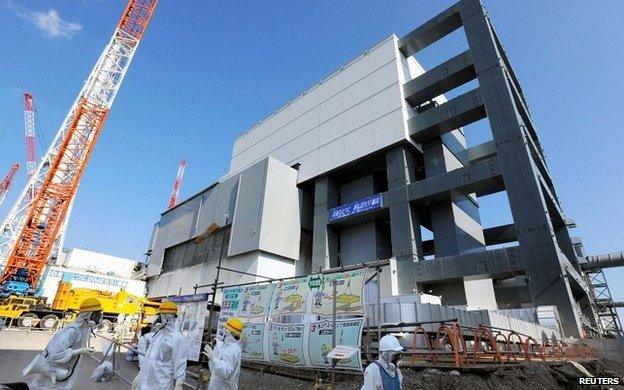Fukushima nuclear plant set for risky operation
- Published
- comments
Rupert Wingfield-Hayes reports from inside Reactor Building 4 at Fukushima
A task of extraordinary delicacy and danger is about to begin at Japan's Fukushima nuclear power station.
Engineers are preparing to extract the first of thousands of nuclear fuel rods from one of the wrecked reactor buildings.
This is seen as an essential but risky step on the long road towards stabilising the site.
The fuel rods are currently in a precarious state in a storage pool in Unit 4.
This building was badly damaged by an explosion in March 2011 following the Great Tohoku earthquake and tsunami.
Moving the rods to safety is a high priority but has only become possible after months of repair work and planning.
One senior official told me: "It's going to be very difficult but it has to happen."
The fuel rods are four-metre long tubes containing pellets of uranium fuel and the fear is that some may have been damaged during the disaster.
When the tsunami struck the Japanese coast, the flood swamped the diesel generators providing back up power to the reactors. Three of the reactors went into a state of partial meltdown.
By coincidence, Unit 4 was undergoing maintenance, so all of its fuel rods were being stored. But the meltdown of a neighbouring reactor led to a build-up of hydrogen which is believed to have led to the explosion in Unit 4.
In the days after the tsunami, there were fears that the blast had damaged Unit 4's storage pool and, in desperation, the authorities used helicopters and fire hoses to keep it filled with water.
A guiding principle of nuclear safety is that the fuel is kept underwater at all times - contact with the air risks overheating and triggering a release that could spread contamination.
So the operation to remove the rods will be painstaking.
A senior official in the Ministry of Economy, Trade and Industry (METI) told me that the rod assemblies will be lifted out in batches of 22 and in casks filled with water.
This will be done with a new crane, recently installed in the wrecked building, after the original one was destroyed.

Moving the rods has only become possible after months of repair work and planning
The task of removing each batch will take 7-10 days, I understand.
Two critically important issues are whether the rods themselves are damaged and therefore likely to leak and whether the casks remain watertight to ensure the rods have no contact with the air.
The METI official acknowledged the risks including a possible "release of radiation" from the fuel or if the casks holding the fuel are dropped.
He said that "countermeasures" have been prepared - including back-up wires to hold the loads and mechanisms to hold the fuel in the event of a power failure.
A briefing document released by the site's owners, Tepco, spells out a series of safety systems designed to minimize the dangers.
For example, the fuel pond itself has been strengthened while the new crane can handle loads of one tonne while the fuel cask only weighs 450kg.
Collision tests, it is said, have shown that even if the fuel cask is dropped, it may be deformed but its seals will not be broken.
The fuel rods will then be deposited into a new "common" pool with a cooling system.
According to the METI official, "the common pool is planned to be used over a long period, supposedly for 10 to 20 years, and will be reinforced against possible future earthquakes and tsunamis".
The Tepco document says the rods will be checked for signs of damage - large amounts of debris fell into the pool during the disaster so the risks are real.
It says that checks for corrosion have found only minor signs so far - with "no corrosion affecting fuel integrity".
But only when the operation begins will engineers get a detailed look at the rods and a chance to assess their state.
One senior figure in Japan's nuclear watchdog told me: "Inspections by camera show that the rods look OK but we're not sure if they're damaged - you never know."
He said Unit 4 presented particular dangers because its entire stock of fuel rods was in the pool at the time of the accident.
If the operation goes as planned, attention will then focus on the massive challenges posed by Units 1, 2 and 3.
According to the METI official, the latest investigations have shown that despite the meltdowns experienced by each reactor, their temperatures have now stabilised.
In Units 1 and 2, readings show the presence of water in what's called the primary containment vessel - suggesting that the melted fuel rods have not penetrated that safety barrier.
The radiation level is too high in Unit 3 for that kind of examination to be carried out but using data from the reactor pressure vessel the official assumes that water is also present in the primary containment.
Meanwhile, the site continues to be plagued by leaks of radioactive water flowing into the Pacific Ocean.
Tepco will not confirm the precise timing of the fuel rod operation but after so much public outrage at the company's handling of the crisis so far, scrutiny of this latest episode will be intense.